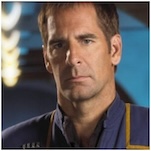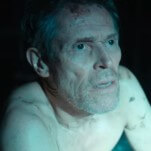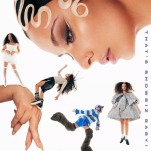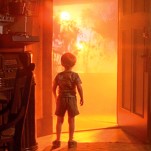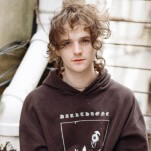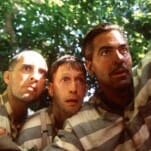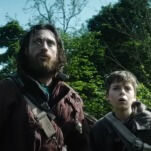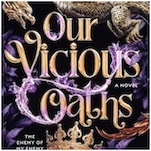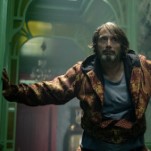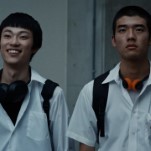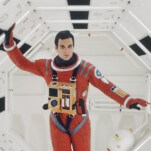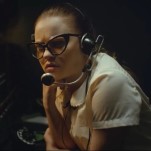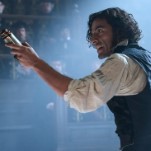The 50 Best Movies on Netflix (September 2025)
A guide to all the best films available to stream on Netflix
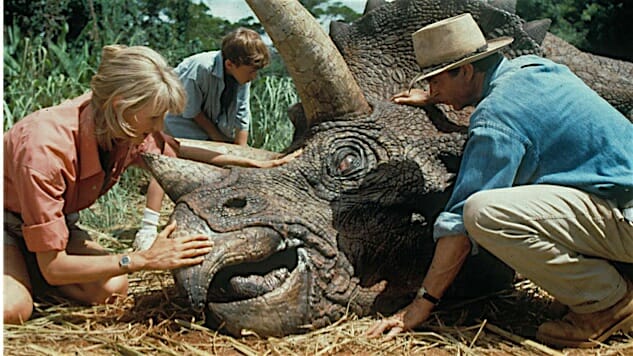
Soon after Netflix first launched its streaming service model in 2007, Paste followed with our first list of the best movies streaming on Netflix. Little did we know that first guide to help movie fans figure out what to watch on a Friday night would help keep us in business during the transition to print—our regularly updated list has since been viewed more than 100 million times, leading us to create separate lists for the best TV shows on Netflix, the best horror movies on Netflix, the best comedies on Netflix and every other genre breakdown you can imagine, as well as guides to the best movies on Amazon Prime, Hulu, Max, Disney+, Apple TV+, Paramount+ and just about every other streaming service out there.
So we take great care to curate this list and bring you fresh selections of movies we think you’ll enjoy, catering to a variety of tastes. We’re film obsessives here and take great pride in helping you find your next movie to watch on the grandfather of streaming services. As the era of Netflix DVDs officially comes to an end, here are the best movies streaming on Netflix right now. —Josh Jackson, Paste co-founder and editor-in-chief
Here are the best movies on Netflix:
1. Parasite
Year: 2019
Director: Bong Joon-ho
Stars: Song Kang Ho, Lee Sun Kyun, Yeo-Jeong Jo, Choi Woo-sik, Park So Dam, Lee Jung Eun
Rating: R
“That’s so metaphorical,” exclaims the son of the Kim family, Ki-woo (Choi Woo-shik), holding with childlike reverie a large rock sculpture, a wooden base solidifying its aesthetic and cultural value. The pointedly nice object stands apart from the basic keepsakes in the Kims’ fairly dingy and cramped home, inhabited by unemployed driver father, Ki-taek (Song Kang-ho), unemployed mother, Chung-sook (Jang Hye-jin), and not-in-art-school daughter, Ki-jeong (Park So-dam). Brought to them by Ki-woo’s wealthy friend, the rock is supposed to foretell great financial wealth to whatever family keeps it in their home. Irritated at their own situation, at the lack of space, at the lack of immediate value the rock has, Chung-sook mutters, “Could’ve brought us food.” In Bong Joon-ho’s Parasite, those that live with a stark awareness of inequality operate with a sense of cognitive dissonance. It’s this paradox of thought that allows Ki-woo to be both naively worshipful towards what a rock sculpture could bring them, but also understand, at other times, that wandering around isn’t how one ascends into power. At the behest of said wealthy friend, he becomes the English tutor for the daughter, Da-hye (Jung Ji-so), of the grotesquely affluent Park family: astute patriarch (Lee Sun-kyun), dim matriarch (Cho Yeo-jeong), manic artsy son, Da-song (Jung Hyun-joon), and severely loyal housekeeper, Moon-gwang (Lee Jung-eun). But as the Kim and Park families grow increasingly closer, both the differences and similarities between them blur beyond discernment. Bong’s interest in income inequality and class has spanned the majority of his career, examining the ways it impacts the justice system (Memories of Murder, Mother), the environment (Okja) and the institutions responsible for both the exacerbation of wealth inequality and failing to protect those most marginalized by that inequality (Snowpiercer, The Host). For Parasite, Bong takes a slightly different angle—he’s no less interested in inequality’s consequences, but here he sees how class as performance manifests, particularly when people are plucked from one echelon of society and put in another. As we watch both families act in different, but intersecting, pieces of social/anthropological theatre, Bong cuts through their mutual hunger, and what ultimately and tragically separates them, with a jaundiced eye and an acidic sense of humor. Laughing during Parasite feels like choking on rust. (Cho, especially, finds the perfect amount of absurdity as the somewhat doltish mother, truly a testament to rich ladies being easily knocked over by a feather.) But Bong is not interested in metaphor, and not the kind written on rocks. Even through its absurdist, bleakly satirical lens, Bong understands that social inequity is not just theatre, but lived experience. Sometimes the rock is just a shit-stained rock. —Kyle Turner
2. Jurassic Park
Year: 1994
Director: Steven Spielberg
Stars: Sam Neill, Laura Dern, Jeff Goldblum, Richard Attenborough, Samuel L. Jackson, BD Wong, Wayne Knight
Rating: PG-13
Jurassic Park’s standing as a technical milestone in cinematic storytelling isn’t only dependent on its then-revolutionary use of computer generated imagery: The special effects look as groundbreaking and seamless today as they did 25 years ago. The magic behind the film’s ability to bring dinosaurs to life could be in Spielberg’s expertise in approaching special effects on a shot-by-shot basis, merging each sequence with reliable miniature and animatronic work, making the connective tissue between these tricks as unnoticeable as possible. More than an achievement, Jurassic Park is an infinitely fun action adventure that also manages to insert some prescient themes into the mix—like whether or not humanity should interfere, on a deeply intimate level, with Nature—affording a moral angle that the sequels have pretty much abandoned or just plain bungled so far. —Oktay Ege Kozak
3. Jaws
Year: 1975
Director: Steven Spielberg
Stars: Roy Scheider, Richard Dreyfuss, Robert Shaw, Lorraine Gary, Murray Hamilton
Rating: PG
Is Jaws a horror film? For those who worry that it’s “not safe to go back in the water,” then most certainly it is. But regardless of how you’d classify it, there’s no denying that Jaws is anything but brilliant, one of Spielberg’s great populist triumphs, alongside the likes of Jurassic Park and E.T., but leaner and less polished than either,. Much has been made over the years of how Jaws as a film really benefits from the technical issues that plagued its making; the story originally called for more scenes featuring the mechanical shark “Bruce,” but the constantly malfunctioning animatronic forced the director to cut back, which ended up maximizing each appearance’s impact. The first time that Brody (Roy Scheider) sees the literal “jaws” of the beast while absentmindedly throwing chum into the water is one of the great, scream-inducing moments in cinema history, and it’s a shock that has rarely been matched in any other shark movie since. Likewise with the death of Quint (Robert Shaw), whose mad scramble to avoid those gnashing teeth is the kind of thing that created its very own sub-genre of children’s nightmares. Ultimately, Jaws is a great film via memorable characters, but a scary film care of novelty and perfect execution. —Jim Vorel
4. Past Lives
Year: 2023
Director: Celine Song
Stars: Greta Lee, Teo Yoo, John Magaro
Rating: PG-13
Named partially for inyun—a Korean concept encompassing fate, intention and consequence, like a reincarnation-bridging butterfly effect—Past Lives’ bittersweet romance brings to mind Longfellow’s ships passing in the night. Not because the decades-spanning relationship between Greta Lee’s Nora and Teo Yoo’s Hae Sung is inconsequential, but because it is consequential in spite of its briefness and its emotional opacity. It reminds us that it is possible to encounter magic, conjured by the flow of everyday actions, when we pass people multiple times along our lives’ intertwining rivers. It reminds us that tethering your life to someone else’s to brave the current together is an act of defiant perseverance. Drawing from a long tradition of yearning romances, while showcasing debut writer/director Celine Song’s unique abilities with precise writing and delicate scene-crafting, Past Lives flows from decade to decade with ease, encompassing immigration, coming-of-age, and creative and romantic ennui—only to reach a heartrending acceptance of our exquisite inability to have it all. Nora isn’t really caught between East and West, just as she is never really caught between her childhood crush Hae Sung and her husband Arthur (John Magaro). Whenever we meet her—whether as a kid, about to leave Hae Sung and Korea behind, or as a twentysomething connecting with him on Skype, or as a married woman hosting his visit to New York—she’s made her choices, or has had them made for her. Song’s strongest thematic thrust as she navigates the film’s three acts—spanning Nora’s childhood, loneliness, reconnection, loss and re-reconnection—is that this isn’t exceptional. Drawing from her own experience and a keen sense of psychology, Song writes clever, contained, jewel box conversations. They can have the hesitant, rekindling awkwardness of Yi Yi, or—thanks to an effective use of hairstyling and wardrobe (as well as the posture and demeanor of its leads)—the ambling melancholy of Richard Linklater’s meditations on time’s passage. But they all allow Lee and Yoo (both in star-making performances) quiet depth. Past Lives is a powerful and delicate debut, a beautiful necklace strung with crystalized memories. Its ideas on love and time, and how one impacts the other, are simple and sear across your heart. It is about all the potential people we could have been, and how none of them matter as much as the person we are—and the fool’s errand of trying to figure out what we’d be if we cobbled ourselves together differently. Those possibilities are best left in the past. Besides announcing Song as a brilliant observer of dialogue, interaction, and tone, Past Lives is a strikingly romantic movie about what composes our lives. We are the decisions we make, and the decisions others make for us. But we are also the collection of connections we make, living ship’s logs, dutifully recorded. Each repeat encounter is a minor miracle, and every first encounter has that potential. And there can be love in each, however brief.—Jacob Oller
5. E.T. the Extra-Terrestrial
Year: 1982
Director: Steven Spielberg
Stars: Henry Thomas, Drew Barrymore, Dee Wallace, Peter Coyote
Rating: PG
Steven Spielberg’s classic is many things: an ode to friendship which resonates with children and adults alike, one of the top-grossing films of all time and the moment Spielberg’s career, on a scale of 1-10, reached 11. Though the Academy would not award Spielberg the Best Director trophy until there were more Nazis involved, E.T. remains today perhaps the most deft expression of his directorial hand. —Michael Burgin
6. Godzilla Minus One
Year: 2023
Director: Takashi Yamazaki
Stars: Ryunosuke Kamiki, Minami Hamabe, Yuki Yamada, Munetaka Aoki, Hidetaka Yoshioka, Sakura Ando, Kuranosuke Sasaki
Rating: PG-13
Big G returns in utterly triumphant fashion in 2023’s Godzilla Minus One, which immediately feels like the most direct corollary to Gojira that the series has ever produced, while thoughtfully modernizing so many of its elements. Wisely, despite the transition to full-on CGI effects to bring Godzilla to life, the creators still capture his stiff, upright movement as it’s always been, the physical remnant of having been played by a man in a suit. Rarely, however, has the sheer mass of the monster been captured so vividly and terrifyingly as it is here, as we watch whole sections of roadway buckle and leap into the air after each of his thunderous footfalls–not to mention the incredible destructive spectacle of his atomic breath. This Godzilla is genuinely terrifying, a rampaging beast without an ounce of mercy or nobility to him. This likewise results in the odd situation where we actually find ourselves genuinely rooting for the human characters to vanquish and defeat Godzilla for once, a rare state of mind for the Godzilla series that is empowered by Minus One‘s sympathetic protagonist Kōichi Shikishima, a man trying desperately to find either a reason to live or the courage to die following the horrors of the second world war. He’s surrounded by salt-of-the-earth Japanese citizens who band together to overcome a truly impossible-seeming obstacle, with an unexpectedly hopeful depiction of human ingenuity and selflessness. An absolutely outstanding kaiju film in general, and one of the few to ever successfully make the human characters an effective center of the action.–Jim Vorel
7. The Departed
Year: 2006
Director: Martin Scorsese
Stars: Leonardo DiCaprio, Matt Damon, Jack Nicholson, Mark Wahlberg, Martin Sheen, Ray Winstone
Rating: R
At times truly funny and at others brutally violent, Scorsese’s ambitious gangster flick spends equal time exploring the deceitful inner workings of the Boston Special Investigation Unit and it’s pro-crime counterpart, the Frank Costello-led Irish mafia. The director’s first gangster film to be set in Boston won him his first Best Picture Award at the Oscars. Featuring an all-star cast in the likes of Matt Damon, Leonardo DiCaprio and Jack Nicholson, the gangster drama, a remake of the Hong Kong thriller Infernal Affairs, upholds the optimum qualities of a classic Scorsese picture: style, morality and grit. —David Roark
8. Inglourious Basterds
Year: 2009
Director: Quentin Tarantino
Stars: Brad Pitt, Christoph Waltz, Melanie Laurent, Diane Kruger, Eli Roth, Michael Fassbender, Daniel Brühl
Rating: R
Quentin Tarantino’s dual loves of vengeance and cinema have never had a purer expression than the face of a Jewish cinematheque owner projected Oz-like onto the smoke of Nazis aflame. The story goes like this: In the middle of the war, propagandist Joseph Goebbels plans to screen his latest pro-Nazi film for the party’s elite at a small Parisian theatre that is, unbeknownst to Goebbels, run by Shosanna Dreyfus (Melanie Laurent)—whose family was killed by SS officer Hans Landa (Christoph Waltz, evil incarnate with a gentleman’s face), and who is working in collaboration with American Aldo Raine (Brad Pitt) and his squad of Nazi-scalping Jewish soldiers. To an almost touching degree, Inglourious Basterds recognizes that the vengeance driving so many films—and certainly Tarantino’s own—is a cinematic impulse, a fantasy of light and sound, cleanly separated from common sense and actual history. It’s flippant, but in Tarantino’s low-rent, pulpy way, Basterds celebrates the well-known cases of Jewish resistance. —Robert Davis
9. Stand By Me
Year: 1986
Director: Rob Reiner
Stars: Wil Wheaton, River Phoenix, Corey Feldman
Rating: R
Stephen King has referred to Stand By Me as one of the best-adapted of his films, which is curious, because it’s such a sincere film, hitting only some of the author’s signature themes. Still, it really captures some of the mythological aspects of childhood—the way the junkyard dog’s fearsome reputation can’t possibly stand up to reality, or how friendship can be a source of healing or how friendships change after innocence is lost. Gordie Lachance’s (Wil Wheaton) group of friends are the kinds of pals one has as a child: They come from very different worlds, but haven’t yet learned that they’re not supposed to hang out together. Would that real-life friendships could persist and reflect these ones more often. —Jim Vorel
10. The Irishman
Year: 2019
Director: Martin Scorsese
Stars: Robert De Niro, Al Pacino, Joe Pesci, Jesse Plemons, Anna Paquin
Rating: R
Peggy Sheeran (Lucy Gallina) watches her father, Frank (Robert De Niro), through a door left ajar as he packs his suitcase for a work trip in this 2019 Martin Scorsese film and Netflix’s best original movie. In go trousers and shirts, each neatly tucked and folded against the luggage’s interior. In goes the snubnose revolver, the ruthless tool of Frank’s trade. He doesn’t know his daughter’s eyes are on him; she’s constitutionally quiet, and remains so throughout most of their interaction as adults. He shuts the case. She disappears behind the door. Her judgment lingers. The scene plays out one third of the way into The Irishman, named for Frank’s mob world sobriquet, and replays in its final shot, as Frank, old, decrepit and utterly, hopelessly alone, abandoned by his family and bereft of his gangster friends through the passage of time, sits on his nursing home bed. Maybe he’s waiting for Death, but most likely he’s waiting for Peggy (played as an adult by Anna Paquin), who disowned him and has no intention of forgiving him his sins. Peggy serves as Scorsese’s moral arbiter. She’s a harsh judge: The film takes a dim view of machismo as couched in the realm of mafiosa and mugs. When Scorsese’s principal characters aren’t scheming or paying off schemes in acts of violence, they’re throwing temper tantrums, eating ice cream or in an extreme case slap-fighting in a desperately pathetic throwdown. The Irishman spans the 1950s to the early 2000s, the years Frank worked for the Bufalino crime family, led by Russell (Joe Pesci, out of retirement and intimidating). “Working” means murdering some people, muscling others, even blowing up a car or a building when the occasion warrants. When disengaged from gangland terrorism, he’s at home reading the paper, watching the news, dragging Peggy to the local grocer to give him a beatdown for shoving her. The Irishman is historical nonfiction, chronicling Sheeran’s life, and through his life the lives of the Bufalinos and their associates, particularly those who died before their time (that being most of them). It’s also a portrait of childhood cast in the shadow of dispassionate brutality, and what a young girl must do to find safety in a world defined by bloodshed. —Andy Crump
11. Dazed and Confused
Year: 1993
Director: Richard Linklater
Stars: Jason London, Joey Lauren Adams, Milla Jovovich, Shawn Andrews, Rory Cochrane, Adam Goldberg, Anthony Rapp, Marissa Ribisi, Wiley Wiggins, Ben Affleck, Parker Posey, Matthew McConaughey
Rating: R
Set in 1976 Texas, Dazed and Confused flows from one group of high-school and middle-school students over the course of one night—the traditional cinematic one-night-that-changes-everything.— Richard Linklater’s follow-up to Slacker shows a variety of vantage points on a number of issues, philosophical, political and otherwise. The camera lingers, offering multiple perspectives, and allowing you to take your time and consider all sides of these various excursions. Ultimately, these digressions circle back on one another, and Linklater forms them into a coherent narrative that resembles an updated American Graffiti for a new generation. As the day begins, there is a very rose-tinted-glasses style outlook on the whole scene, one that is, layer by layer, peeled away over the course of the ensuing evening. For all the seeming importance placed on things like playing football, chasing romantic partners and finding some good old-fashioned visceral experiences, there isn’t much in the way of consequences. You may get your ass kicked a little bit, but there isn’t a lot at stake. Whatever happens, you’ll be fine. This is never more apparent than as Dazed and Confused draws to a close and the film takes a dark turn towards what can only be described as adulthood. —Brent McKnight
12. Hit Man
Year: 2024
Director: Richard Linklater
Stars: Glen Powell, Adria Arjona, Austin Amelio, Retta
Rating: R
Armed with the kind of star wattage capable of outshining his co-stars, Glen Powell has cemented himself as a leading man. With the raucous comedy Hit Man (which he co-wrote with director Richard Linklater), Powell crafts a character that can ground its delightful and relentless series of plot twists. While Linklater and Powell’s last collaboration worked under the guise of an ensemble in Everybody Wants Some!!, Powell is the definitive protagonist of Hit Man. Gary (Powell) is a bumbling, lovable philosophy professor who works part-time with the undercover division of the New Orleans police department. He loves his cats, has a good relationship with his ex-wife and drives a sturdy, practical Honda Civic. When fellow detective Jasper (Austin Amelio), undercover as a hitman, is pulled from a case for misbehavior, Gary steps in, relishing the chance to immerse himself in another life, free from moral reasoning and the trappings of normality. Once he encounters the sweet and desperate Madison (Adria Arjona), who wants to rid herself of an abusive, domineering husband, his life spins into chaos. While the film weaves together colorful, tonally specific threads with relative ease, it is dominated by its romantic and comic impulses, following Madison and Gary’s relationship with unwavering focus. This requires unbidden chemistry between the two leads, a multi-hyphenate source of energy that both insulates them and propels the story forward. Powell and Arjona are up to the task, gravitating towards each other and leaning into every suggestive conversation with startling ease. Gary’s lessons in philosophy slowly coalesce with his personal experiences in Carrie Bradshaw-esque fashion. It is here that Hit Man feels somewhat shallow and underdeveloped, trying to shoehorn grander life lessons into a relatively simple relational set-up. While the ambition of such a storytelling move isn’t totally unwelcome, it does take the audience on an unnecessarily bumpy ride, forcing them to ascribe deeper meaning to a purely physical, chemistry-riddled expression of cinema. Arjona and Powell leave as the victors of this light excursion, following in the footsteps of Henry Fonda and Barbara Stanwyck, with shades of Cary Grant coloring Powell’s playful physicality. He is spry and breezy, thriving in the informality of the silly premise he and Linklater rip from real life (Hit Man is based on a Texas Monthly article by the same man who covered Bernie’s real-life inspiration). With such charming old-school performances, Hit Man peels back the layers of genre to reveal something alive–lovely in its full-bodied animation.—Anna McKibbin
13. The Piano Lesson
Year: 2024
Director: Malcolm Washington
Stars: John David Washington, Samuel L. Jackson, Ray Fisher, Michael Potts, Erykah Badu, Skylar Aleece Smith, Danielle Deadwyler, Corey Hawkins
Rating: PG-13
As John David Washington gets older, it’s almost uncanny how much he sometimes echoes the look and cadence of his father, Denzel. But he’s particularly coming into his own as a formidable actor in this piece, playing Boy Willie’s bluster and interior fortitude with a lot of considered maturity. Deadwyler does even heavier work here as the family member literally carrying the sorrow of her whole family on her shoulders, while trying not to be swallowed up by the past or what is expected of her societally. She gets supported nicely by a quiet and compassionate performance by Ray Fisher as Boy Willie’s friend, Lymon. Michael Potts as Winning Boy and Corey Hawkins as Avery also do fine work, providing a lot of contextual flavor to the family from their outsider’s perspectives, which makes the narrative feel less insular. Perhaps the most impactful adjustment to this piece, though, is how Malcolm Washington leans into the gothic supernatural elements literally haunting this family. He’s woven throughout a simmering yet potent horror film-within-a-film that creates layers of dread and mystery that really pays off emotionally in the final act. Supported well by Mike Gioulakis’ eerie cinematography and Alexandre Desplat’s restrained score, the emphasis on the ghostly manifestations of their past inside their house, and in this piano, gives Wilson’s subtext a more pointed interpretation that arguably only a film, with all of its more subtle layers of aesthetic design, could pull off so well. Malcolm Washington is very assured with his blending of genres, which honors and invigorates Wilson’s classic play. The Piano Lesson is an adaptation, and a directorial debut that absolutely has me excited for what he attempts next. —Tara Bennett
14. Train to Busan
Year: 2016
Director: Yeon Sang-ho
Stars: Gong Yoo, Ma Dong-seok, Jung Yu-mi, Kim Su-an, Kim Eui-sung, Choi Woo-shik, Ahn So-hee
Rating: N/A
Love them or hate them, zombies are still a constant of the horror genre, dependable enough to set your conductor’s watch by. And although I’ve probably seen enough indie zombie films at this point to eschew them from my viewing habits for the rest of my life, there is still usually at least one great zombie movie every other year. In 2016, that was Train to Busan, a film that has since been added to our list of the “50 Best Zombie Movies of All Time”:https://www.pastemagazine.com/articles/2016/09/the-50-best-zombie-movies-of-all-time.html. There’s no need for speculation: Train to Busan would undoubtedly have made the list. This South Korean story of a career-minded father attempting to protect his young daughter on a train full of rampaging zombies is equal parts suspenseful popcorn entertainment and genuinely affecting family drama. It concludes with several action elements that I’ve never seen before, or even considered for a zombie film, and any time you can add something truly novel to the genre of the walking dead, then you’re definitely doing something right. With a few memorable, empathetic supporting characters and some top-notch makeup FX, you’ve got one of the best zombie movies of the past decade. —Jim Vorel
15. She’s Gotta Have It
Year: 1986
Director: Spike Lee
Stars: Tracy Camila Johns, Spike Lee, John Canada Terrell, Tommy Redmond Hicks
Rating: R
Netflix doesn’t have a lot of great movies from the 1980s, but this is a wonderful exception. An explosively frank feature debut that immediately announced Lee’s brave, fresh new voice in American cinema, She’s Gotta Have It, shot like a documentary, is a levelheaded exploration of a young black woman named Nola (Tracy Camilla Johns) trying to decide between her three male lovers, while also flirting with her apparent bisexuality, in order to, first and foremost, figure out what makes her happy. What’s refreshing about the film is that Lee always brings up the possibility that “none of the above” is a perfectly viable answer for both Nola and for single women—a game changer in 1986. The DIY indie grainy black-and-white cinematography boosts the film’s in-your-face realism. —Oktay Ege Kozak
16. Guillermo del Toro’s Pinocchio
Year: 2022
Director: Guillermo del Toro, Mark Gustafson
Stars: Ewan McGregor, David Bradley, Gregory Mann, Ron Perlman, Finn Wolfhard, Christoph Waltz, Tilda Swinton, Cate Blanchett
Rating: PG
Guillermo del Toro has never shied away from infusing the harsh realities of life and death into the journeys of his young protagonists. His fascination with the intersections of childhood innocence and macabre whimsy are what make him the ideal co-director of Netflix’s newest Pinocchio adaptation, a work that marvelously marries the filmmaker’s flair for dark fantasy with the equally strange fairy tale elements of Carlo Collodi’s 1883 The Adventures of Pinocchio. Like all successful marriages, Guillermo del Toro’s Pinocchio brings out the very best of both parties. The stop-motion musical is an artistic triumph that colors Collodi’s cherished storybook characters with humanity and depth to craft a mature tale about rebellion, mortality and the love between a parent and child. This rendition marks the 22nd film adaptation of the Italian novel, and while it remains true to the grisly nature of Collodi’s original stories, it boldly departs from its dated moral lessons. In The Adventures of Pinocchio (and notable renditions thereafter), Pinocchio’s many escapades are structured as cause-and-effect narratives that serve to caution children against defiant behavior. In Disney’s 1940 animated feature, an evening of fun and relaxation on “Pleasure Island’’ nearly turns the wooden boy into a salt-mining donkey. In the original serial La Storia di un Burattino, delinquent behavior leads him to a gruesome death. These values of compliance and servility are reversed by del Toro’s fascist setting. In his Pinocchio, disobedience is a virtue—not a crime. These moral examinations are given a sense of urgency in death—a theme that informs so much of the film’s mind and soul. Where previous adaptations are preoccupied with life—with the puppet’s extraordinary consciousness and the hope that he may someday become a “real boy”—del Toro’s Pinocchio is interested in what our mortality can teach us about being human. In the film, death is never too far away from the protagonist or his loved ones. Death touches Carlo, then remains close to Pinocchio throughout his epic journey. The beauty of del Toro’s Pinocchio is that death isn’t treated with the usual dread and cynicism we typically see in the Western world. Here, death is mysterious, ethereal, soaked in gorgeous blue light. Death is not something to be feared, but respected and accepted when the time comes, because the notion that we will someday—maybe unexpectedly—leave this earth is what makes our time here so beautiful. I don’t typically advise listening to crickets, but believe Sebastian J., because the story of Pinocchio has never been told quite like this. It’s the best kids movie on Netflix.—Kathy Michelle Chacón
17. Kubo and the Two Strings
Year: 2016
Director: Travis Knight
Stars: Art Parkinson, Charlize Theron, Matthew McConaughey, Ralph Fiennes, Rooney Mara
Rating: PG
Most parents give their kids a curfew, but most kids aren’t related to kabuki-masked wraiths and heartless lunar gods who want to murder them, either. Seems like good incentive for Kubo (Art Parkinson) to listen to his mother, which he does until he doesn’t. The minute he breaks mom’s number one rule, Kubo endures the world’s most unfortunate family reunion and undertakes the quest for his birthright, guarded along the way by an ill-tempered monkey and a flaky man-beetle-warrior, named, respectively, Monkey (Charlize Theron) and Beetle (Matthew McConaughey). Yes, fine, Kubo and the Two Strings doesn’t go deep in the tank for character names. Big deal. The film funnels imagination into an Erlenmeyer flask where narrative reacts with aesthetic. It’s a stunningly rendered adventure that treats style and substance as one and the same.—Andy Crump
18. Daughters
Year: 2024
Director: Natalie Rae, Angela Patton
Stars: Hugh Bonneville, Ben Winshaw, Sally Hawkins, Julie Walters, Jim Broadbent, Peter Capaldi, Nicole Kidman
Rating: NR
For ten long weeks, men who are incarcerated in a Washington, D.C. prison eagerly anticipate a rare opportunity to reunite with their daughters in the profoundly moving documentary feature Daughters. The film from co-directors Natalie Rae and Angela Patton follows these fathers and their children as they prepare for a “Date with Dad” dance that will allow them to be reunited for six hours, a rare opportunity for physical connection as prisons across the board begin to limit in-person visitations. As part of the two-and-a-half-month lead-up to the dance, those eligible to participate complete a fatherhood coaching program, entailing an informal roundtable where the men are able to express their complicated feelings about their own upbringings and anxieties over their mandated absence. Rawly exposing the cruelty imposed upon predominantly Black children by the carceral state while also capturing the emotional whiplash of this fleeting encounter, Rae and Patton construct a visually stunning and narratively resonant portrait of love and longing. Lensed with love yet unabashedly committed to its nuanced depiction of familial strain—as well as the social systems that beget this separation—Daughters is a testament to the power of a father’s love and support, no matter the obstacle.—Natalia Keogan
19. Edge of Tomorrow
Year: 2014
Director: Doug Liman
Stars: Tom Cruise, Emily Blunt, Bill Paxton, Brendan Gleeson
Rating: PG-13
Major William Cage (Tom Cruise) spends his days in the film’s near-future setting spinning the armed forces’ ongoing efforts against a hostile alien race (dubbed Mimics) without ever setting foot on a battlefield. At least until a gruff general (Brendan Gleeson) sends him on a particularly dicey mission. The result is Cage’s death, but the story doesn’t end there. Instead Cage awakes at the beginning of the day he died with his memory intact, and quickly discovers the resurrections will recur every time he dies. His only hope of escaping the endless cycle lies with super-soldier Rita Vrataski (Emily Blunt), who knows from experience exactly how Cage might be able to use this new ability to help humanity win the war of the worlds. Based on the manga All You Need Is Kill by Hiroshi Sakurazaka and adapted for the screen by Christopher McQuarrie (Cruise’s current go-to director completely in sync with his physically-defying action spectacle) and Jez and John-Henry Butterworth, Edge of Tomorrow recalls other notable time loop sagas, including Groundhog Dayand Source Code in the witty and engaging way it moves its story forward piece by piece. As Cage relives the same day over and over again, he also learns how to become a true soldier, trains with (and falls for) Rita, discovers how the aliens function and ever so patiently formulates the perfect plan of attack. Like a video game hero with infinite lives, Cage has the opportunity to refine and correct every mistake he makes along the way. However long Cage is on that journey, Edge of Tomorrow is a blast, and Cruise carries the surprisingly amusing action like a pro—his skill with deadpan comedy proving even more valuable than his infamous enthusiasm for sacrificing his flesh over and over and over. —Geoff Berkshire
20. Wayne’s World
Year: 1992
Director: Penelope Spheeris
Stars: Mike Meyers, Dana Carvey, Rob Lowe, Tia Carrere, Brian Doyle Murray, Lara Flynn Boyle
Rating: PG-13
Ever since the genesis of the duo on SNL, Wayne Campbell and Garth Algar were always proud broadcasters from “Cable 10 Public Access in Aurora, Illinois,” and those Midwestern sensibilities lie at the very heart of both the sketches and the two feature films. Wayne is exactly the sort of genial, goodhearted but fairly dim everyman slacker so often lampooned in other shows of the same period based in the Midwest (most notably MST3k). He still lives in the basement of his parents’ suburban home, the big fish in an extremely small pond of local broadcasting, without any real ambitions even to expand the scope of Wayne’s World. One might actually say his lack of vision or ambition is presented as a virtue: Wayne and Garth are just simple people, happy with what they have, where Rob Lowe’s antagonist character, Benjamin, is an upwardly mobile schemer. These are exactly the roles you expect to see characters play when set in the realistic, somewhat milquetoast setting of Illinois suburbia. —Jim Vorel
21. Wallace & Gromit: Vengeance Most Fowl
Year: 2024
Director: Nick Park, Merlin Crossingham
Stars: Ben Whitehead, Peter Kay, Lauren Patel, Reece Shearsmith
Rating: PG
It’s a testament to the effectiveness of an animated story if it can immerse you in its setting and familiarize you with the essence of its characters in a matter of minutes, even if the setting and characters in question are beloved icons that are nevertheless almost totally unknown to the viewer. And that makes the instantly approachable nature of creator Nick Park’s work all the more apparent in the upcoming, Netflix-hosted feature film Wallace & Gromit: Vengeance Most Fowl–within minutes of sitting down to stream a press preview, it began to feel like I’d known the titular duo for decades already. That’s how winningly and simply effective the archetype of these characters remains to this day–it doesn’t matter if you don’t know a thing about them; they still win you over immediately.
This kind of joyful, cheerful excess is the through-line of Wallace & Gromit: Vengeance Most Fowl, from the duo’s massively overengineered home filled with gadgets to solve nonexistent problems, to the steadily mounting action sequences that make up the film’s third act, the highlight of which involves a slow-speed canal boat chase that somehow builds itself to life-or-death stakes. The light satire on technological dependency, meanwhile, is appreciated but almost unnecessary in comparison with the simple joys of the lovingly detailed stop-motion animated movements and expressiveness. The film’s entire arc, in fact, is more or less entirely predictable, but it just doesn’t matter–it’s an old-fashioned charmer that only registers as that much more refreshing for the lack of similarly animated fare in the modern industry. And yes, that includes Aardman Animations Limited’s own disappointing return to Chicken Run with last year’s Dawn of the Nugget. Unlike that would-be franchise, the central, wholesome allure of Wallace & Gromit remains undiminished. —Jim Vorel
22. Talk to Me
Year: 2023
Director: Danny Philippou, Michael Philippou
Stars: Sophie Wilde, Miranda Otto, Alexandra Jensen, Joe Bird, Otis Dhanji, Zoe Terakes, Chris Alosio
Rating: R
Talk to Me, the feature directorial debut of RackaRacka YouTube creators Danny and Michael Philippou is fierce, fun, and steeped in youthful energy. It’s a film that’s willing to go to some truly dark places in its exploration of grief, death and what it means when we reach too far into the beyond, but it’s also never afraid to laugh along the way. Talk to Me is a séance story, specifically a séance story revolving around a severed, ceramic-encased hand with a mysterious history. These days, the hand is hanging out in the possession of some Australian teenagers, who break it out at parties for 90-second “talk to me” sessions in which partygoers can briefly commune with, and be possessed by, the dead. It’s a quick thrill, the kind of thing perfect for taking smartphone videos to share on social media, and it’s all so detached and laugh-worthy that people either think it’s fake or liken it to a more pedestrian thrill like a drug trip. But when teenage Mia (Sophie Wilde), who recently lost her mother, hears about the hand, she’s eager to see if she actually can reach the other side, where her lost Mom might be waiting. Her best friend Jade (Alexandra Jensen) thinks it’s all fake, but she’s still willing to accompany Mia to a party, where a brief encounter with the hand will change both their lives. This is, even non-horror devotees will notice, a riff on classic séance narratives in which humans open a door that’s not to be trifled with, and let something dark and dangerous out. Talk to Me never tries to mask its roots in time-honored formulas, but approaches its tropes and recognizable story beats with an earnestness that’s both endearing and frank. And the horror, when it hits, hits with visceral intensity. Anyone who’s ever seen a RackaRacka horror short knows how well the Philippou brothers can craft a surprising scare, and those scares emerge with real ferocity in Talk to Me. At a time when we spend far too much energy trying to swing horror movies into one side or the other of a senseless binary, Talk to Me reminds us that fun and true existential terror don’t have to be mutually exclusive areas of storytelling. Talk to Me is as funny as it is frightening, as poignant as it is pulse-pounding, and the whole thing is rooted in a modern reality that feels like you could step into it tomorrow, which only adds to both the humor and the fear.—Matthew Jackson
23. The Mitchells vs. the Machines
Year: 2021
Director: Mike Rianda, Jeff Rowe (co-director)
Stars: Abbi Jacobson, Danny McBride, Maya Rudolph, Eric Andre, Fred Armisen, Beck Bennett, Olivia Colman
Animated generational divides have never been more like a sci-fi carnival than in The Mitchells vs. the Machines. Writer/director Mike Rianda’s feature debut (he and co-writer/director Jeff Rowe made their bones on the excellently spooky, silly show Gravity Falls) is equal parts absurd, endearing and terrifying. It’s easy to feel as lost or overwhelmed by the flashing lights and exhilarating sights as the central family fighting on one side of the title’s grudge match, but it’s equally easy to come away with the exhausted glee of a long, weary theme park outing’s aftermath. Its genre-embedded family bursts through every messy, jam-packed frame like they’re trying to escape (they often are), and in the process create the most energetic, endearing animated comedy so far this year. And its premise begins so humbly. Filmmaker and animator Katie (Abbi Jacobson) is leaving home for college and, to get there, has to go on a road trip with her family: Rick (Danny McBride), her Luddite outdoorsy dad; Linda (Maya Rudolph), her peacemaking mom; and Aaron (Rianda), her dino-freak little brother. You might be able to guess that Katie and her dad don’t always see eye-to-eye, even when Katie’s eyes aren’t glued to her phone or laptop. That technocriticism, where “screen time” is a dirty phrase and the stick-shifting, cabin-building father figure wants his family to experience the real world, could be as hacky as the twelfth season of a Tim Allen sitcom. The Mitchells vs. the Machines escapes that danger not only through some intentional nuance in its writing, but also some big ol’ anti-nuance: Partway through the trip, the evil tech companies screw up and phone-grown robots decide to shoot all the humans into space. This movie needed something this narratively large to support its gloriously kitchen-sink visuals. The Sony film uses some of the same tech that made Spider-Man: Into the Spiderverse look so crisp and unique, adding comicky shading to its expressive CG. In fact, once some of the more freaky setpieces take off, you wouldn’t be surprised to see Miles Morales swing in to save the day. The Mitchells vs. the Machines’ spin on the Spidey aesthetic comes from meme and movie-obsessed Katie, whose imagination often breaks through into the real world and whose bizarre, neon and filter-ridden sketchbook doodles ornament the film’s already exciting palette with explosive oddity. This unique and savvy style meshes well with The Mitchells vs. the Machines’ wonderfully timed slapstick, crashing and smashing with an unexpected violence, balanced out with one truly dorky pug and plenty of visual asides poking fun at whatever happens to be going on.—Jacob Oller
24. Da 5 Bloods
Year: 2020
Director: Spike Lee
Stars: Clarke Peters, Delroy Lindo, Norman Lewis, Isiah Whitlock Jr., Chadwick Boseman, Jonathan Majors
Rating: R
The hunt for buried gold neither ends well nor goes off without a hitch. The long road to reconciliation, whether with one’s trauma, family or national identity, is never without bumps. Glue these truths together with the weathering effects of institutional racism, add myriad references to history—American history, music history, film history—and you get Spike Lee’s Da 5 Bloods, a classically styled Vietnam action picture made in his cinematic vision. As in 2018’s BlacKkKlansman, Lee connects the dots between past and present, linking the struggle for civil rights couched in conscientious objection and protest to contemporary America’s own struggle against state-sanctioned fascism. After opening with a montage of events comprising and figures speaking out against the Vietnam War, referred to predominantly as the American War throughout the rest of the movie, Lee introduces four of the five bloods: Otis (Clarke Peters), Paul (Delroy Lindo), Eddie (Norm Lewis) and Melvin (Isiah Whitlock Jr.), bonded Vietnam vets returned to Ho Chi Minh City ostensibly to find and recover the bones of their fallen squad leader, Norman (Chadwick Boseman). There’s more, of course, “more” being around $17 million in gold bars planted in Vietnamese soil, property of the CIA but reappropriated by the Bloods as reparations for their personal suffering as men fighting a war for a country governed by people who don’t care about their rights. Lee’s at the height of his powers when bluntly making the case that for as much time as has passed since the Vietnam War’s conclusion, America’s still stubbornly waging the same wars on its own people and, for that matter, the rest of the world. And Lee is still angry at and discontent with the status quo, being the continued oppression of Black Americans through police brutality, voter suppression and medical neglect. In this context, Da 5 Bloods’ breadth is almost necessary. As Paul would say: Right on. —Andy Crump
25. Wet Hot American Summer
Year: 2001
Director: David Wain
Stars: Michael Showalter, Paul Rudd, David Hyde Pierce, Janeane Garofalo, Ken Marino, Michael Ian Black, Marguerite Moreau, Elizabeth Banks, Joe Lo Truglio, Molly Shannon, Christopher Meloni
Rating: R
A cult film that’s long since surpassed that status, Wet Hot American Summer is a lot of things: It’s hilarious; it’s perfectly cast; and it’s a clear demonstration that Christopher Meloni has more range than simply playing a dour sex crime detective. But what makes it so brilliant, 15 years later and with a Netflix series on lock, is that it’s so painfully, relentlessly nihilistic. We could trade quotable lines for days (my personal favorites being what Jon Benjamin’s can of vegetables admits he’s acrobatically capable of, and then Paul Rudd bluntly refusing to make out with Elizabeth Banks’s character due to her burger flavor), but the key to the movie’s endurance—past its timelessness grounded in a specific brand of ’80s sex romp flick—is the way in which it treats nostalgia. Like Wain, Michael Showalter and Michael Ian Black’s Stella series, Wet Hot American Summer, which takes place over the course of Camp Firewood’s last day, exists in a bleakly amoral world. Here, bad things happen to good people—and really only to good people. Wain takes innocence and obliterates it, punishes it, gleefully destroying all nice memories anyone would ever hold dear about long lost summers, first loves and youth. Without a shred of wistfulness, Wet Hot American Summer surpasses its origins in parody and becomes something more: It earns its comedy. Taunting our very explicitly American tendency to let everything we touch devolve into sentimentality, the film proves that when we obsess over remembering ourselves at our best, we might as well be celebrating us at our worst. —Dom Sinacola
26. The Sea Beast
Year: 2022
Director: Chris Williams
Stars: Karl Urban, Zaris-Angel Hator, Jared Harris, Marianne Jean-Baptiste, Dan Stevens, Kathy Burke
Rating: PG
When cartographers allowed their senses of imagination and self-preservation to fill the unexplored regions of their maps, they used to warn of creatures like lions, elephants and walruses. Creatures beyond understanding, with teeth and trunks and tusks easy to caricature into danger. But we mostly remember that when you sail to the faded edge of knowledge, there be dragons. The Sea Beast deftly hones this ancient human fear into a sharpened spear tip, striking at ignorance. Its swashbuckling adventure navigates a sea filled with massive critters sure to whet kids’ appetites for piracy, Godzilla films and exciting animation. The first movie from longtime Disney story staple Chris Williams after leaving the House of Mouse for Netflix, The Sea Beast is, to paraphrase Jared Harris’ Ahab-like Captain Crow, all piss and vinegar. That the film even alludes to the phrase, and drops a few other lightly-salted lines you might expect from some seasoned sea dogs, is indicative of its separation from the sanitized juggernaut. It looks violence in the eye; it isn’t afraid to make its threats real. All rightfully so. Telling a tall tale of hunters—mercenary crews funded by a colonialist crown to take out the kaijus populating the ocean—wouldn’t be right without at least a little edge. Our way into the world, the young Maisie (Zaris-Angel Hator), has experienced its dangerous realities firsthand: Her parents went down with a ship, leaving her as one of dozens of hunter orphans. But that hasn’t stopped her from lionizing her martyred family (something explicitly encouraged by the monarchy) and seeking her own glory. Stowing away on Crow’s ship, the Inevitable, she and the capable Jacob (Karl Urban) find themselves confronting the legendary ambitions they’ve built up in their own heads. Williams and co-writer Nell Benjamin immediately drop us into the Inevitable’s quest to take out Crow’s toothy and horned Red Whale, dubbed the Red Bluster, with total confidence that there’s no time like maritime. As our eyes roll and pitch across the impressively realistic waves and our ears try to follow the meticulously detailed helmsmanship, the hunting scenes ensnare us like the catch of the day. We understand the hierarchy of the diverse crew, the honor code among hunters, the tactics needed to take down imposing creatures that look like Toho turned their greatest hits into Pokémon. It’s savvy and respectful writing, put into legible action by Williams’ skilled hand, that trusts in its setting and subject matter to be inherently cool, and in its audience to greedily follow along. By the time the lances are flying, the cannons are firing and the creatures are dying—or are they?–you’re as deeply hooked as any dad watching Master and Commander. A delightful new-school deconstruction of old-school Romantic adventure that never compromises on the lushness of setting, color and emotion inherent in the latter, The Sea Beast rises to the front of Netflix’s animated offerings like a high tide.–Jacob Oller
27. The Disciple
Year: 2021
Director: Chaitanya Tamhane
Stars: Aditya Modak, Arun Dravid, Sumitra Bhave
Rating: TV-MA
Devoting your life to something—art, passion, religion—is sold to us as admirable, but often only if it fulfills our romantic ideals of what that life looks like. Is success, no matter how late or even posthumous, the justification for striving? Writer/director/editor Chaitanya Tamhane explores this idea through the life of classical Indian singer Sharad Nerulkar (Aditya Modak), an earnest hardliner raised by his music-loving father and recordings of legendary singer/guru Maai (Sumitra Bhave). Will he be recognized for greatness, stepping out of the shadows? Or will he follow his father into tangential obscurity? Fascinating long takes resonating with the same kind of richness found in its myriad array of singers’ undulating taan allow us plenty of space to take in the music and the devotion on display; sharp, dark humor punctuates the contemplative film with jabs at pigheadedness. Modok’s excellent performance contains similar depth, all hidden behind a yearning tension and unwavering gaze. He embodies the unfulfilled artist, one who sees success all around him from fools and rubes—though he can’t consider what could possibly be holding him back. It’s a heartbreaking, endearing, prickly performance, and one that creates a truly winning portrait. Even when it rolls along as steadily and dispassionately as Sharad’s motorcycle, The Disciple contains warmth for its central sadsack artist and his dedication to never selling out.—Jacob Oller
28. The Lost Daughter
Year: 2021
Director: Maggie Gyllenhaal
Stars: Olivia Colman, Dakota Johnson, Jessie Buckley, Paul Mescal, Dagmara Dominczyk, Oliver Jackson-Cohen, Peter Sarsgaard, Ed Harris
Rating: R
On the beach that comparative literature scholar Leda (Olivia Colman) lounges on throughout The Lost Daughter, the skies are a crystal blue, the beaches a shimmering white, the water warm and translucent. But the shore is also infested with crass, noisy people; Leda’s fruit infected by a malignant rot; her bedroom contaminated with screeching bugs; a little girl’s doll corrupted by noxious black liquid and writhing insects. This tonal tension is symptomatic of the film’s spirit: It’s a glossy apple, rapidly decaying from the inside out. The film takes place over a couple of days as Leda settles into a lavish working vacation. Her relaxation is interrupted, however, when she first lays eyes on Nina (Dakota Johnson), a beautiful, inscrutable young mother. Leda becomes obsessed with Nina, as the latter inadvertently resurfaces troubling memories of Leda’s own distressing experiences as a mother. From that moment onward, Leda’s haunting memories permeate The Lost Daughter until the apple is completely black. While the narrative itself, adapted from Elena Ferrante’s 2006 novel of the same name, is relatively straightforward, debut director Maggie Gyllenhaal, who also wrote the screenplay, tackles themes of internalized and externalized sexism with agility and complexity. Leda’s subtle, complex mental state would not have been possible to convey were it not for Gyllenhaal’s outstanding visual sensibilities. Leda’s struggles are largely internal, but I’m confident that Gyllenhaal’s uniquely tactile storytelling says a great deal more than words ever could. When Leda caresses Elena’s grimy doll, her touch is gentle and somehow filled with regret. When she slides a pin into Nina’s hat, it sounds sinister like a sword being unsheathed, but her careful placement is almost sensual. And when a younger Leda slices the flesh of an orange, her smooth, tactful carving almost feels ominous. Gyllenhaal’s extraordinary direction, paired with exceptional performances from The Lost Daughter’s lead actresses, culminate in a perfect storm that yields an astute portrait of the painful expectations of womanhood.—Aurora Amidon
29. The Blues Brothers
Year: 1980
Director: John Landis
Stars: John Belushi, Dan Aykroyd, James B. Brown
Rating: R
For an intensely absurd, farcical comedy, The Blues Brothers is so much more sincere than one would ever expect it to be, both in its adoration of classic blues and R&B and the way it captured a moment in the life of the city of Chicago. Indeed, this John Landis classic lovingly shows off a Chicago that no longer exists in several instances, most notably the Maxwell Street Market, Chicago’s great open-air flea market where one could buy just about anything, legal or illegal, and also gave birth to both Chicago blues and the famed Maxwell Street Polish sausage before the city forcibly moved the market to make room for university housing among other things. It doesn’t try to put a shine on the city, showing both the high-rent (the Richard J. Daley Center) and the low (Elwood’s flophouse, numerous low-income neighborhoods) right alongside one another. This is just one of those films that completely changes the popular conception of a cityscape–if you go to Chicago, you will start picking out things from The Blues Brothers. Trying driving on Lower Wacker Drive without thinking about the Bluesmobile rocketing along and police cars smashing into one another in absurdly spectacular pile-ups. It can’t be done. It might be Chicago’s single most beloved cinematic representation.–Jim Vorel
30. Under the Shadow
Year: 2016
Director: Babak Anvari
Stars: Narges Rashidi, Avin Manshadi, Bobby Naderi, Ray Haratian, Arash Marandi
Rating: PG-13
For most of the film, Babak Anvari is crafting a stifling period drama, a horror movie of a different sort that tangibly conveys the claustrophobia of Iran during its tumultuous post-revolution period. Anvari, himself of a family that eventually fled the Ayatollah’s rule, has made Under the Shadow as statement of rebellion and tribute to his own mother. It’s a distinctly feminist film: Shideh (Narges Rashidi) is cast as the tough heroine fighting back against greater hostile forces—a horror movie archetype that takes on even more potency in this setting. Seeing Shideh defy the Khomeini regime by watching a Jane Fonda workout video, banned by the state, is almost as stirring as seeing her overcome her personal demons by protecting her child from a more literal one. —Brogan Morris
31. RRR
Year: 2022
Director: S. S. Rajamouli
Stars: N. T. Rama Rao Jr., Ram Charan, Ajay Devgn, Alia Bhatt, Shriya Saran, Samuthirakani, Ray Stevenson, Alison Doody, Olivia Morris
Rating: NR
A Telugu epic rivalling even the over-the-top antics of writer/director S. S. Rajamouli’s previous massive blockbusters (the two Baahubali films), RRR’s endearingly repetitive and simple title reflects a three-hour romp through Indian colonial history filled with the primal pleasures of brotherhood and balls. Almost cartoonishly political, its story of star-crossed besties Alluri Sitarama Raju (Ram Charan) and Komaram Bheem (N. T. Rama Rao Jr.) is one focused on shallow contrasts masking bone-deep similarities. Based on two superheroicized revolutionaries—ones that never, but should have, saved a child by simultaneously bungeeing a tethered motorcycle and horse over opposite sides of a bridge—the at-odds heroes represent the rural and urban poles opposing the British colonizers. Caricatures of the urbane heartthrob and the noble backwoods beast, the two embodiments of cultural pride battle CG beasts, ridiculous Brits and each other—though you can’t help but hope they end up holding each other tight. (They do squats while riding each other piggyback. C’mon.) Their back-and-forth, glisteningly homoerotic friendship walks a taut narrative tightrope, but with the movie’s maximalist filmmaking as its balancing rod. A phenomenally thrumming and amusingly worded soundtrack accompanies some of the year’s most bombastic action sequences and charming dance scenes without mussing a single mustache hair. The two beefy and hyper-masculine leads span silent comedy, musical song-and-dance prowess and elegant fight choreography as the kind of do-it-all stars we just don’t get in the U.S. anymore. As their morally turbulent path rages against the pure evil of the cruel white oppressors, any doubt that RRR is a modern myth fades deep into the shadows of the jungle. Overflowing with symbols, political shorthand and stereotypes of all kinds, RRR rises, roars and revolts with raw cinematic power—and enough fascinating density to warrant watching and discussing over and over again.—Jacob Oller
32. Starship Troopers
Year: 1997
Director: Paul Verhoeven
Stars: Casper Van Dien, Dina Meyer, Denise Richards, Jake Busey, Neil Patrick Harris, Patrick Muldoon, Michael Ironside
Rating: R
Glistening agitprop after-school special and gross-ass bacchanalia, Paul Verhoeven’s Starship Troopers delights in the ultraviolence it doles out in heavy spurts–but then chastises itself for having so much fun with something so wrong. Telling the story of a cadre of extremely attractive upper-middle-class white teens (played by shiny adults Casper Van Dien, Denise Richards, Nina Meyers, Jake Busey and Neil Patrick Harris) who get their cherries popped and then ground into hamburger inside the abattoir of interstellar war, Verhoeven cruises through the many tones of bellicose filmmaking: hawkish propaganda, gritty action setpieces and thrilling adventure sequences, all of it accompanied by plenty of gut-churning CGI, giant space bugs and human heads alike exploding without shame or recourse or respect for basic physics and human empathy. As much a bloodletting of Verhoeven’s childhood trauma, forged in the fascist mill of World War II Europe, as a critique of Hollywood’s cavalier attitude toward violence and uniformly heroic depictions of the military, the sci-fi spectacle can’t help but arrive at the same place no matter which angle one takes: geeked out on some hardcore cinematic mayhem. –Dom Sinacola
33. The Other Side of the Wind
Year: 2018
Director: Orson Welles
Stars: John Huston, Peter Bogdanovich, Robert Random, Susan Strasberg, Oja Kodar
Rating: R
As gaudy and inexplicable as its title, The Other Side of the Wind nonetheless sings with the force of its movement whistling past its constraints. The wind blows: Orson Welles channels it through his studio-inflicted/self-inflicted torpor, in that process finding an organic melody—or rather, jazz. The making-of documentary They’ll Love Me When I’m Dead, released by Netflix to go with this film—the streaming giant’s finest moment—shows Welles, enormous and half-baked, describing what he calls “divine accidents.” These accidents were responsible for some of his oeuvre’s best details (wherein God resides), like the breaking of the egg in Touch of Evil; they were something he aimed to chase after (like chasing the wind) with this, his final project, released several decades after its shooting as Netflix opened their coffers to open the coffin in which the raw footage was locked. His former partners on the shoot, Peter Bogdanovich and Frank Marshall, make good on their old oath to their master to complete the film for him, and in finding the spirit of the thing, deliver us a masterpiece we barely deserve. A divine accident. John Huston plays John Huston as Jake Hannaford who is also Orson Welles, trying to finish The Other Side of the Wind much like Welles tried to finish The Other Side of the Wind, over the course of years with no real budget and by the seats-of-everyone’s-pants. In contrast, the film’s scenario is set up over the course of one evening and night, Hannaford surrounded by “disciples” and peers who are invited to a party to screen some of the footage of what the director hopes will be his greatest masterpiece, in what Welles hoped would be his. The film within the film is a riff on art film, with perhaps the strongest winks at Michelangelo Antonioni and Zabriskie Point. Life imitates art: Hannaford’s house is just around the rock corner from the one Zabriskie blew to bits. Aptly, that house is the setting for most of the film about Hannaford, in theory constructed from found footage from the cineaste paparazzi. The density is dizzying, the intellect fierce. In terms of Welles’ filmography, it’s like the last act of Citizen Kane felt up by Touch of Evil, then stripped and gutted by the meta-punk of F for Fake. No art exists in a vacuum, but The Other Side of the Wind, more than most, bleeds its own context. It is about Orson Welles, showing himself. Killing himself. —Chad Betz
34. Dick Johnson Is Dead
Year: 2020
Director: Kirsten Johnson
Rating: PG-13
If every great documentary is about the responsibility of observation, then Kirsten Johnson’s Cameraperson is also about the fragility of that observation. With her follow-up, Dick Johnson Is Dead, Johnson continues to interrogate that fragility, crafting a deeply personal ode to that over which she has no control: her father’s death. It helps that Dick Johnson is a mellifluous soul, an incessantly warm and beaming man surrounded by friends and colleagues and acquaintances who all uniformly, genuinely love him, but from its opening shots, Johnson makes it clear that her father’s wonderful nature will only make saying goodbye to him that much more difficult. And the time when she must do so looms closer and closer. Her impetus, she reluctantly acknowledges, is partly selfish as she decides to help acquaint her father with the end of his life, reenacting in lavish cinematic vignettes the many ways in which he could go out, from falling air conditioner unit, to nail-festooned 2×4 to the face, to your run-of-the-mill tumble down the stairs, replete with broken neck. The more Johnson loses herself in the project, spending more effort consulting stunt people and art directors and assorted crew members than her own dad (sitting peacefully on set, usually napping, never being much of a bother), the more she realizes she may be exploiting someone she loves—someone who is beginning to show the alarming signs of dementia and can no longer fully grasp the high concept to which he once agreed—to assuage her own anxiety. As her dad’s memory dissipates along with his ability to take care of himself, Dick Johnson Is Dead caters less to Dick’s need to preserve some sense of immortality than to his daughter’s need, all of our need, to let go. —Dom Sinacola
35. Nimona
Year: 2023
Director: Nick Bruno, Troy Quane
Stars: Chloë Grace Moretz, Riz Ahmed, Eugene Lee Yang, Frances Conroy, Lorraine Toussaint, Beck Bennett, Indya Moore, RuPaul, Julio Torres, Sarah Sherman
Rating: PG
You know that joke about how we would all side with the queer-coded villains of our childhood? ND Stevenson’s now decade-old webcomic-turned-graphic-novel Nimona is a commitment to that bit. Like its source material, Nimona is a legend for the freaks and the queers, a story told in figures, archetypes and tropes. Nimona understands that villains are often made villainous for their bodies and identities. Nimona embraces queer coding and turns it into a subversive power fantasy. In the original webcomic, Nimona is a queer anarchist revolutionary who adopts the brown-skinned, disabled Boldheart as her master. He has found himself conned into maintaining the status quo as the villain that the forces of power in his kingdom need, but he gets to prolong his homoerotic rivalry with his nemesis and ex-lover, the Institute’s champion and white pretty boy, Goldenloin. Together, Nimona and Boldheart can, through villainy, actually take down the shockingly malicious Institute that maintains strict order over the kingdom and inspire their followers to see the world differently. There’s no sympathizing with royalists here. You should absolutely go read Nimona. It won’t take much longer to read than it will to watch the 99-minute film (and you should watch it after), but with that space, Stevenson establishes and subverts the archetypes and tropes that shape not just narrative, but world view. It’s not subversive of just form or structure, but of narrative and ideology. Now in the hands of Spies in Disguise directorial duo Nick Bruno and Troy Quane, Nimona is roughly the same chaotic gremlin that fans of Stevenson’s work loved—with some notable reworks to fit into an animated kids movie on Netflix. It kinda skips the whole villain arc of the original story, which I would be more annoyed about if the many other adjustments and the reworked scope didn’t make this such a good standalone adaptation. The movie still captures the heart of Nimona. It may make for a less subversive take on villainy, but remains a thoughtful commentary on systems of power and the othering of non-normative bodies. In many ways, it feels tailored for this moment, for this audience. —Autumn Wright
36. Roma
Year: 2014
Director: Alfonso Cuarón
Stars: Yalitza Aparicio, Marina de Tavira, Diego Cortina Autrey, Carlos Peralta
Rating: R
The decision to invest in a black-and-white film from beloved auteur Alfonso Cuarón was a statement that Netflix wanted to produce great original cinema. And Cuarón’s most intimate film is also his most distancing. The camera sits back, black-and-white, focused not on the bourgeois children that represent the cinematographer-writer-director and his siblings growing up in Mexico City several decades ago, but moreso on the indigenous woman (Yalitza Aparicio) that cares for them and the household. Not even entirely focused on her, perhaps more focused on its classicist compositions of a place that no longer exists in the way Cuarón remembers it. The camera gazes and moves in trans-plane sequencing, giving us foreground, mid-ground and background elements in stark digital clarity. The sound mix is Dolby Atmos and enveloping. But the base aesthetic and narrative is Fellini, or long-lost Mexican neorealism, or Tati’s Playtime but with sight gags replaced by social concern and personal reverie. Reserved and immersive, introspective and outward-looking, old and new—some have accused Roma of being too calculated in what it tries to do, the balancing act it tries to pull off. Perhaps they’re not wrong, but it is to Cuarón’s immense credit as a thoughtful technician and storyteller that he does, in fact, pull it off. The result is a singular film experience, one that recreates something that was lost and then navigates it in such a way as to find the emergent story, then from that to find the emotional impact. So that when we come to that point late in Roma, we don’t even realize the slow, organic process by which we’ve been invested fully into the film; we’re not ready to be hit as hard as we are when the wallops come and the waves crash. It’s almost unbearable, but we bear it because we care about these people we’ve become involved with. And such is life. —Chad Betz
37. Glass Onion: A Knives Out Mystery
Year: 2022
Director: Rian Johnson
Stars: Daniel Craig, Janelle Monae, Ed Norton, Kate Hudson, Kathryn Hahn, Dave Bautista, Leslie Odom Jr., Jessica Henwick, Madelyn Cline
Rating: PG-13
In Rian Johnson’s latest Knives Out mystery, the Glass Onion is as much a metaphor for the nature of the whodunit as it is for the grandeur of the film itself. Resting upon a gorgeous Greek villa (on a billionaire’s private island, no less), the titular emblem is created through a combination of VFX and a practical structure that stands a mighty 20 meters high. Made in the U.K. from all-glass paneling, the Onion’s design was so intricate that it had to be assembled in its birthplace first to ensure that all its pieces fit together, disassembled entirely for its journey to a Serbian studio and then reassembled for the film. This extravagance perfuses beyond budget and set design to inform key elements of the overall work—most notably, its characters, sense of humor and roller coaster narrative. In Glass Onion, everything is more. More jokes. More self-reflexivity. More twists and turns. And, undeniably, more fun. Peeling back the layers of this campy mystery is none other than Benoit Blanc (Daniel Craig), “The Last of the Gentlemen Sleuths.” He opens a mixed bag of eccentric personalities, including unfiltered fashion designer Birdie Jay (Kate Hudson), Connecticut governor Claire Debella (Kathryn Hahn), mysterious scientist Lionel Toussaint (Leslie Odom Jr.), men’s rights influencer Duke Cody (Dave Bautista), wealthy entrepreneur Miles Bron (Edward Norton) and Andi Brand (Janelle Monáe), his estranged business partner. This absurdly delightful cast and gags are accompanied by a narrative that mirrors their chaos and lightheartedness. Where Knives Out is a straight whodunit, this second installment is more of an adoring parody of the subgenre. From recurring jokes about Clue to the utilization of famous novella tropes, the film dives headfirst into all things murder-mystery. It has multiple puzzles layered onto each other to create a viewing experience jam-packed with revelations and shocks—hence its overarching onion metaphor. Glass Onion is the kind of crowd-pleasing entertainment that is best experienced in a group setting, where the film’s topsy-turvy take on the whodunit is sure to keep you guessing (and laughing).—Kathy Michelle Chacón
38. 1917
Year: 2019
Director: Sam Mendes
Stars: George McKay, Dean-Charles Chapman, Mark Strong, Andrew Scott, Richard Madden, Claire Duburcq, Colin Firth, Benedict Cumberbatch
Rating: R
One suspects that Sam Mendes’ latest film might have made a bigger splash at the box office with slightly different timing. Like most cinematic sub-genres that have experienced robust popularity and saturation during a decade or two, the war movie benefits from “lying fallow.” (Someday, the same will be true for superhero films, as well.) With Dunkirk, another artfully shot and presented war film—albeit a different World War—still “fresh” in movie-goers’ minds, and another type of Wars movies dominating discussion, it seems unlikely many from those most sought-after demographics are going to say, “Hey, you know what I want to see? A film set during World War I!” No matter that both its director and cinematographer have Oscar statuettes, or that the latter is the Roger Deakins (no slight to Mendes—but just check out “Deakins’ resumé”:https://en.wikipedia.org/wiki/Roger_Deakins). Nonetheless, 1917 is one of the most technically challenging and visually satisfying movies of the year. The “continuous shot” approach, so often a gimmick in lesser films, is executed here with such deftness that it’s fascinating to observe in and of itself—it’s like watching a juggler or tightrope walker pull off a routine …for two straight hours. In this case, the approach meshes perfectly with the setting and story, pulling the viewer into the tension of trench warfare and the overall horror of a prolonged stay in a place where the enemy is always trying to kill you, while also achieving a certain character-centric intensity that may feel familiar to anyone who has logged many hours in videogames. (It may sound strange to praise a film in those terms, but “viewer immersion” is one quality to which all great art—from brows low to high—aspires.) As a result, if you give 1917 an inch of attention, it will drag you along for miles. —Michael Burgin
39. Rolling Thunder Revue: A Bob Dylan Story by Martin Scorsese
Year: 2019
Director: Martin Scorsese
Rating: NR
Bob Dylan’s life and career are so encased in myth that it can be hard to untangle the romanticism from the reality. As much a symbol as he is a man, Dylan has spent most of his adulthood resisting being labeled the voice of his generation while slyly welcoming fans’ desire to dissect his every utterance, devoting much of the last couple decades opening up the vaults to release a series of official “bootleg” recordings associated with his most iconic albums and tours. He invites us to look deeper and listen harder, as if the answers can be gleaned from closer study. Long before David Bowie, Tom Waits, Madonna or Lady Gaga dabbled in persona play, Robert Zimmerman made us ponder masks in popular music. He’s both there and not there, which can be frustrating and fascinating. Both sensations are on display in Rolling Thunder Revue, the oft-spectacular, sometimes shtick-y chronicle of Dylan’s 1975 Rolling Thunder tour. As is typical when depicting anything in the Dylan universe, this concert film/documentary simultaneously oversells its subject’s genius and provides overwhelming evidence of what a brilliant artist he is. The documentary’s full title should also be a disclaimer: Rolling Thunder Revue: A Bob Dylan Story by Martin Scorsese. Early on, the movie features a contemporary interview from Dylan confessing that he doesn’t quite remember what prompted Rolling Thunder or what his ambitions were. “I don’t have a clue because it’s about nothing,” he says, another example of obscuration and seduction. The movie is a “story,” which means some parts might be invented or exaggerated, and because it’s “by Martin Scorsese,” the whole film is filtered through one artist’s perspective on another. Scorsese is after something grander than mere documentation—more layers of myth are applied while trying to present an honest account of a tour and a performer. At nearly two-and-a-half hours, Rolling Thunder Revue is overlong but also overpowering, inconclusive yet undeniably stirring. It left me exhausted, but I kinda want to see it again. —Tim Grierson
40. Blue Giant
Year: 2023
Directors: Yuzuru Tachikawa
Stars: Amane Okayama, Yuki Yamada, Shotaro Mamiya
Rating: NR
In his first feature since wrapping the critically acclaimed third season of Mob Psycho 100, director Yuzuru Tachikawa takes on the hallowed musical anime. Adapted from Shinichi Ishizuka’s ongoing manga series, Blue Giant is a film about a boy who wants to become the greatest jazz musician in the world, as he takes the most consequential step of his journey: Moving to Tokyo to break into the dying scene. Dai (Yuki Yamada), having left his hometown with a backpack and tenor sax, imposes on an old friend who moved to the city for college. He’s quickly met with the fact that there’s not enough venues left to make playing for money a possibility and begins working to pay his now-roommate Shunji (Amane Okayama) rent while scouring the city for musicians. He quickly meets pianist Yukinori (Shotaro Mamiya), who, unlike Dai, was surrounded by music at a young age. The two’s contrasting backgrounds and proximity to the world of professional music leads them to butt heads and build each other up the way rivalries-turned-bromances do in sports anime. Yukinori is more jaded, but also more technically proficient; Dai’s spirit undeniably comes through his sax’s sound. In anime, at least, that’s enough. With manga editor Number 8 penning the screenplay, Blue Giant feels remarkably concise despite its two-hour runtime. The original manga starts years earlier when Dai gives up basketball to pursue sax after discovering jazz music, but here we focus on a pivotal make-or-break moment and get the full arc of the trio’s development. A solid quarter of that runtime is dedicated to musical performances. More than most films, pianist and composer Hiromi Uehara had an outsized role in shaping Blue Giant. With saxophonist Tomoaki Baba and drummer Shun Ishiwaka, Uehara performs original compositions in addition to her orchestral score. They’re great. They’re perhaps not as mind-melting as the performances in film, with Dai nearly going Super Saiyan as he glows and bends space around him, but great nonetheless. But there’s a narrow gulf between good 3DCG (Chainsaw Man) and bad 3DCG (2016’s Berserk)—it either works or it doesn’t. And here it mostly does not. This formal shift is hard to pull off, and something I’ve only really seen done convincingly by MAPPA and Khara, and the camerawork in these moments doesn’t feel interesting enough to justify this direction. Still, the 3DCG’s use being limited to only parts of the musical sequences keep it from greatly deterring more sensitive eyes. And outside of these scenes, there are some conspicuously gorgeous highlights as well, with detailed nighttime cityscapes looking, at times, lifted from Mamoru Oshii’s Patlabor. Blue Giant is a somewhat tropey story that captures its characters’ big feelings, and its incorporation of live combo recordings contributes something unique to the steadily growing canon of musical anime.—Autumn Wright
41. The Power of the Dog
Year: 2021
Director: Jane Campion
Stars: Benedict Cumberbatch, Kirsten Dunst, Jesse Plemons, Kodi Smit-McPhee, Thomasin McKenzie, Genevieve Lemon, Keith Carradine, Frances Conroy
Rating: R
Based on the 1967 novel of the same name by Thomas Savage, Jane Campion’s long-awaited return to the medium of film—following 2009’s Bright Star and her subsequent years spent working in television—feels apt for a director who has demonstrated prowess at crafting an atmosphere of acute disquiet. And so it goes for The Power of the Dog, a film with a perpetual twitching vein, carried by the ubiquitous feeling that someone could snap at any moment—until they do. In 1925 Montana, brothers Phil (Benedict Cumberbatch) and George Burbank (Jesse Plemons) are prosperous cattle ranchers but incompatible siblings. Phil is the ultimate image of machismo, brooding around the ranch ever adorned in his cowboy outfit and a thick layer of grime on his face, a rolled cigarette hanging against his lower lip; a character that acts in defiance of Cumberbatch’s past work. Phil is so opposed to anything even adjacent to what could be considered “feminine” that things like bathing, playing an instrument that isn’t a banjo and just being nice to women are the kinds of activities which might lead Phil to inquire “Fellas, is it gay if…?” on Twitter. From the castration of the bulls on the Burbank ranch, to Phil’s status as the black sheep of his respectable family, to the nature of the western landscape tied to Phil’s performance of masculinity, the subtext is so visually hamfisted that it remains subtextual only by virtue of it not being directly spoken out loud. But the clumsiness in the film’s approach to its subject matter is propped up by the compelling performances across the board—notably from Cumberbatch, whose embodiment of a gruff and grubby rancher is at first sort of laughably unbelievable in relation to the performances that have defined the Englishman’s career. But it is, perhaps, because of this very contrast to his past roles that Cumberbatch manages to fit into the character of Phil so acutely, carrying with him an inherent awkwardness and unrest in his own skin despite the terror that he strikes in the heart of someone like Rose. He’s matched by the chilling score, composed by the inimitable Johnny Greenwood (The Master, Phantom Thread), and impeccable cinematography from Ari Wegner (Zola, The True History of the Kelly Gang), which form a perfect union of tension, intimacy and isolation in a film where the sound of every slice, snip and click evokes the same distressing sensation regardless of the source. What does it mean to be a man? The Power of the Dog considers the question but never answers it. Instead, it is preoccupied with a timeless phenomenon: The suffering endured for the very sake of manhood itself. —Brianna Zigler
42. Ma Rainey’s Black Bottom
Year: 2020
Director: George C. Wolfe
Stars: Viola Davis, Chadwick Boseman, Glynn Turman, Colman Domingo, Michael Potts
Rating: R
Fittingly, Chadwick Boseman’s final role is all about the blues. The late actor’s appearance in Netflix’s Ma Rainey’s Black Bottom, the August Wilson adaptation from director George C. Wolfe and writer Ruben Santiago-Hudson, is equal parts actorly showcase, angry eulogy and comprehensive lament—boiled together in the sweaty kitchen of a ‘20s Chicago recording session. A story of ambition’s multiple facets and eventual endpoints, Ma Rainey revolves around those orbiting its title character (Viola Davis). She’s a blues legend at the top of her game, finally appreciated (at least in some parts of the country) and ripe for exploitation by white men in suits. As if she’d let them. She’s comfortably late to record an album, leaving everyone else to kick up their heels and shoot the shit in true Wilson style—with Santiago-Hudson finding the essence of Wilson’s work. Davis’ brutal performance, made all the more potent by her avalanche of makeup and glistening sweat, perfectly sets the scene. She, alongside loosened neckties and whirring fans, gives the film its intended temperature and gravity so that Boseman and the rest of her band members can zip around like fireflies ambling in the summer heat. With tragic serendipity, Boseman leaves us a gift: he is on fire. Lean, with the camera placements and props emphasizing his gangly limbs (there’s a reason he wields a squashed and squat flugelhorn, a jazz staple that happens to work better visually), Levee is a highly physical role despite the chatty source material: It’s all about capturing attention, sometimes literally tap-dancing for it, with any ounce of shame overrun by an anxious energy. High-strung, twitchy and tense during a nearly five-minute monologue, Levee seems to sense the window to his dream is closing: Time is running out. Ma Rainey’s Black Bottom is more than Boseman’s performance, sure, with Davis and Colman Domingo going on some delicious tears of their own and Wilson’s words continuing to sear and soar in equal measure. But Boseman’s ownership of the film, an Oscar-worthy snapshot of potential and desire, gives an otherwise lovely and broad tragedy something specific to sing about.—Jacob Oller
43. One of Them Days
Year: 2024
Director: Lawrence Lamont
Stars: Keke Palmer, SZA, Katt Williams
Rating: R
One of Them Days, a bright and antic broad comedy, doesn’t carry the same weight as Nope, but it’s also less ephemeral than, say, hosting a redo of Password or showing up for various Jennifer Lopez vanity videos. Unlike those projects, it’s easy enough to imagine this one becoming a beloved and rewatched comfort movie. It follows the reliable one-crazy-day structure, where a couple of straightforward tasks – in this case, pay rent and show up for a job interview – spiral into a digression-heavy schemes and mishaps. The main problem is that Dreux’s roommate and best friend Alyssa (the singer SZA) has delegated the first task to her worthless boyfriend Keshawn (Joshua David Neal), who promptly absconds with the $1,500 owed to their landlord. Now the girls have nine hours to come up with the money, during which Dreux must also nail her interview for a major promotion, hopefully in aid of not running into the same damn problems (however redressed in different clothes) the next month. —Jesse Hassenger
44. The Thursday Murder Club
Year: 2025
Director: Chris Columbus
Stars: Helen Mirren, Pierce Brosnan, Ben Kingsley, Celia Imrie
Rating: PG-13
The concept of little old ladies solving crimes in the village is a British entertainment staple from time immemorial, from Agatha Christie’s Miss Marple, to more modern versions like Anne Cleeves’ Vera Stanhope. In The Thursday Murder Club, a Netflix feature film adaptation of Richard Osman’s bestselling novel of the same name, the elderly crime solving vibes are turned up to eleven, with not one, not two, but four retirees joining forces to try and find the killer in a real-life murder, and maybe save their beloved community home at the same time.
Set at a picturesque retirement village called Coopers Chase, the story follows the titular Thursday Murder Club, a group of well-off pensioners who are secretly true crime junkies in their spare time. They gather each week in one of the facility’s puzzle rooms to discuss and investigate the specifics of unsolved cold cases. There’s Elizabeth (Helen Mirren), the obvious leader of the group, whose mysterious background in “international affairs” has left her with a lot of useful contacts; Ron (Pierce Brosnan), a well-known former trade unionist who made his name as an activist at sit-ins and picket lines; and Ibrahim (Ben Kingsley), a psychiatrist who specialized in treating war veterans with PTSD. Though the group all come from different backgrounds, their enjoyment of crime solving has brought them together and formed a genuine bond between them. The cases are an excuse for them all to get together—but it’s clear almost from their first scenes together that this group doesn’t really need one. They’re already family. —Lacy Baugher Milas
45. The Killer
Year: 2023
Director: David Fincher
Stars: Michael Fassbender, Arliss Howard, Charles Parnell, Kerry O’Malley, Sala Baker, Sophie Charlotte, Tilda Swinton
Rating: R
Naturally, an unnatural filmmaker like David Fincher could only make a hitman movie like The Killer. Adapting a vivid-yet-cold graphic novel into a thrilling-yet-mundane piece of character work, the Titan of Takes meticulously creates a nameless assassin who’d prefer if he wasn’t human at all. A technological man for technological times. Michael Fassbender’s narration-heavy performance as the Killer is one of robotic self-delusion. He is a man who loves perfection, who loves planning. A man who loves challenging executions and loves to think of himself as someone who—if he could just plan enough—is capable of anything. Embedded in his eventual failure is self-effacing humor, mocking this very ideal. It’s easy to pretend that you can optimize your life to programmatic perfection. There’s a whole industry devoted to this capitalistic goal, filled with productivity apps, tech wearables and organizational best practices. The Killer uses this worldview as its setting to ask, “Ok, what happens when you miss?” The Killer isn’t a self-aware guy, and Fincher-favorite writer Andrew Kevin Walker (Seven, rewrites of The Game and Fight Club) knows how to turn obnoxious, comic-like voiceover into revealing psychological commentary. The Killer refers to some suburbanites as “normies,” and you wonder if, after seeing his work co-opted as copypasta, Walker is now conversing directly with the edgelords. Maybe that’s why, despite his surface similarity in appearance, profession and aesthetic to Le Samouraï, the Killer is intentionally not the “cool” kind of hitman. He’s your friend’s dad, always traveling for work, addicted to his Apple Watch and airport amenities. His life is a series of suitcases, lines, and Ubers. Fincher’s process-focused photography—cut with precision by editor Kirk Baxter, framed with hard lines and a little more distance than you expect by cinematographer Erik Messerschmidt—makes it clear the Killer is going through the motions, whether those motions are assembling his sniper in the middle of the night, dumping those gun parts, or stopping by McDonald’s for an Egg McMuffin. Though the characters are irredeemable, the message is universal: We all end up in the same place, so what’s the use in pretending you’ve “solved” life? The unreliable conversation between aesthetics, genre and character creates something realistic, novel and modern—something Fincher is perfectly keyed into. By applying our technocapitalist present to the kind of person that this reality inevitably creates, Fincher’s created a thoroughly entertaining look at a pathetic crook—all while delivering a self-deprecating blow to clockwork living.—Jacob Oller
46. The Paper Tigers
Year: 2021
Director: Bao Tran
Stars: Alain Uy, Ron Yuan, Mykel Shannon Jenkins, Roger Yuan, Matthew Page, Jae Suh Park, Joziah Lagonoy
Rating: PG-13
When you’re a martial artist and your master dies under mysterious circumstances, you avenge their death. It’s what you do. It doesn’t matter if you’re a young man or if you’re firmly living that middle-aged life. Your teacher’s suspicious passing can’t go unanswered. So you grab your fellow disciples, put on your knee brace, pack a jar of IcyHot and a few Ibuprofen, and you put your nose to the ground looking for clues and for the culprit, even as your soft, sapped muscles cry out for a breather. That’s The Paper Tigers in short, a martial arts film from Bao Tran about the distance put between three men and their past glories by the rigors of their 40s. It’s about good old fashioned ass-whooping too, because a martial arts movie without ass-whoopings isn’t much of a movie at all. But Tran balances the meat of the genre (fight scenes) with potatoes (drama) plus a healthy dollop of spice (comedy), to similar effect as Stephen Chow in his own kung fu pastiches, a la Kung Fu Hustle and Shaolin Soccer, the latter being The Paper Tigers’ spiritual kin. Tran’s use of close-up cuts in his fight scenes helps give every punch and kick real impact. Amazing how showing the actor’s reactions to taking a fist to the face suddenly gives the action feeling and gravity, which in turn give the movie meaning to buttress its crowd-pleasing qualities. We need more movies like The Paper Tigers, movies that understand the joy of a well-orchestrated fight (and for that matter how to orchestrate a fight well), that celebrate the “art” in “martial arts” and that know how to make a bum knee into a killer running gag. The realness Tran weaves into his story is welcome, but the smart filmmaking is what makes The Paper Tigers a delight from start to finish.–Andy Crump
47. It’s What’s Inside
Year: 2024
Director: Greg Jardin
Stars: Brittany O’Grady, James Morosini, Gavin Leatherwood, Nina Bloomgarden, Alycia Debnam-Carey, Reina Hardesty, Devon Terrell, David Thompson, Madison Davenport
Rating: R
Masks are important in horror films, but not just the ones you can pluck off a shelf and wear. Jason, Michael, and Ghostface all have their masks, of course, but a good horror film can also focus in on the masks we as regular humans wear at work, at home, or among friends. Who we really are versus who we hope we are is a source of phenomenal dramatic tension in any genre. Throw in some horror concepts and some scary atmosphere and you’ve got what’s (hopefully) a compelling concoction about the fear of facing your true self, and the fear of learning those closest to you aren’t who you thought they were. It’s What’s Inside, the new horror/sci-fi/comedy from writer/director Greg Jardin, is certainly compelling, but it’s what the film does beyond the basic tension of challenging its characters on their own identities that makes its special. Fiendishly clever, beautifully designed, and driven by a great ensemble, it’s a genre-hopping romp that plays like the perfect movie for a Friday night in October, even as it also functions as a nerve-shredding exploration of the masks we wear. —Matthew Jackson
48. Okja
Year: 2017
Director: Bong Joon-ho
Stars: Tilda Swinton, Jake Gyllenhaal, An Seo-hyun, Paul Dano, Steven Yeun
Rating: PG-13
Okja takes more creative risks in its first five minutes than most films take over their entire span, and it doesn’t let up from there. It’s perhaps the finest example yet of the wild pendulum swing of a Bong film’s rhythmic tonality—the culmination of Bong’s unique rhythms into something like a syncopated symphony. The film opens with Tilda Swinton’s corporate maven Lucy Mirando leering out an expository dump of public relations about her new genetically created super-pigs, which will revolutionize the food industry. We’re also introduced to Johnny Wilcox, played by Gyllenhaal as a bundle of wretched tics, like there’s a tightly-wound anime character just waiting to rid itself of its Gyllenhaal flesh, but in the meantime barely contained. Okja is the finest of the super-pigs, raised by a Korean farmer (Byun Hee-bong) and his granddaughter Mija (Ahn Seo-hyun), an orphan. Okja is Mija’s best friend, a crucial part of her family. Bong takes his sweet time with this idyllic life Mija and Okja share. The narrative slows down to observe what feels like a Miyazaki fantasy come to life. Mija whispers in Okja’s ear, and we’re left to wonder what she could possibly be saying. The grandfather has been lying to Mija, telling her he has saved money to buy Okja from the Mirando corporation. There is no buying this pig; it is to be a promotional star for the enterprise. When Johnny Wilcox comes to claim Okja (a sharp note of dissonance in the peaceful surroundings) the grandfather makes up an excuse for Mija to come with him to her parents’ grave. It is there he tells her the truth. Mija’s quest to rescue Okja brings her in alliance with non-violent animal rights activists ALF, which ushers the film into a high-wire act of an adventure where Bong’s penchant for artful set-piece is pushed to new heights. The director works with an ace crew frontlined by one of our greatest living cinematographers, Darius Khondji, who composes every frame of Okja with vibrant virtuosity. The very action of the film becomes action that is concerned with its own ethics. As the caricatures of certain characters loom larger, and the scope of the film stretches more and more into the borderline surreal, one realizes that the Okja is a modern, moral fable. It’s not a film about veganism, but it is a film that asks how we can find integrity and, above all, how we can act humanely towards other creatures, humans included. The answers Okja reaches are simple and vital, and without really speaking them it helps you hear those answers for yourself because it has asked all the right questions, and it has asked them in a way that is intensely engaging. —Chad Betz
49. May December
Year: 2023
Director: Todd Haynes
Stars: Natalie Portman, Julianne Moore, Charles Melton
Rating: R
Partway through Todd Haynes’ May December, actor Elizabeth Berry (Natalie Portman) is asked how she chooses her roles by a group of high school drama students. Elizabeth is in town to research her upcoming lead role in a ripped-from-the-tabloids independent movie, a part she hopes will be statement enough to eclipse the work she’s currently recognized for (playing a veterinarian on a show called Norah’s Ark, just one of screenwriter Samy Burch’s winky little jokes about the biz). Her next part is decidedly not as family friendly: Elizabeth is set to play Gracie Atherton-Yoo (Julianne Moore), a former teacher who made the news 20 years ago for having a sexual relationship with and subsequently marrying one of her seventh-grade students, Joe (Charles Melton). May December offers up a tantalizingly ambiguous answer to the question posed during that drama class visit. As she insinuates herself into the Atherton-Yoos’ life—tagging along with Gracie and her daughter Mary (Elizabeth Yu) as they shop for prom dresses, taking notes on the makeup brands Gracie uses, shadowing Joe at work—we begin to wonder whether Elizabeth’s devotion to the role comes only from a desperate desire to be taken seriously as an actor, or if there’s something deeper and darker lurking within. Burch’s script—and Portman’s brilliantly cryptic performance—keep these possibilities balanced on a fine edge. We’re never completely sure if Elizabeth is just going ultra-Method when, for example, she complains that the boys auditioning for the part of young Joe aren’t “sexy enough,” or when she visits the pet shop stockroom where the couple were first discovered and simulates the sexual encounter that led to Gracie’s arrest. The disturbing possibility that the two women are secretly more alike than Elizabeth lets on only grows when she talks to the drama students about sex scenes—telling them that, sometimes, the acting is in pretending she’s not enjoying them. That smudging of the line between Gracie and Elizabeth physically manifests in the gradual converging of their appearances in cinematographer Christopher Blauvelt’s inspired Bergman-esque images. May December is a film of great tonal delicacy, as Haynes, Burch and their actors delicately modulate the film between high camp and twisted psychological drama. Pulling off such a seemingly incongruous blend of sensationalism and sincere thoughtfulness is no easy task, but writer and director miraculously find a way to ease the tension between style and substance—and, what’s more, manage to deliver wry commentary on the way we consume scandals at the same time.–Farah Cheded
50. Upgrade
Year: 2018
Director: Leigh Whannell
Stars: Logan Marshall-Green, Betty Gabriel, Harrison Gilbertson
Rating: R
Lovers of high-concept, b-movie sci-fi cinema would have been perfectly content were Upgrade not much more than a narratively streamlined, giddily hyper-violent vigilante revenge fantasy, sort of a Death Wish: Cyberpunk Edition. However, Upgrade is also sophisticated enough to leave the audience with some intriguing questions about how much power we can give artificial intelligence before it decides that we’re a nuisance, taking full control. Of course, the premise of AI as existential threat is the bedrock for plenty of science fiction, with a recent example in Alex Garland’s great Ex Machina. With Upgrade, we get a Cliff’s Notes version of this concept, examined in an understandably superficial but original way, and we get to watch a bad guy’s head split in half. That’s the textbook definition of a win-win. —Oktay Ege Kozak

